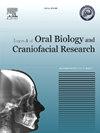Acute oral toxicity and mucosal irritation of a mouthwash containing chlorhexidine and chlorine dioxide in animal models
Q1 Medicine
Journal of oral biology and craniofacial research
Pub Date : 2025-05-17
DOI:10.1016/j.jobcr.2025.04.013
引用次数: 0
Abstract
Background
Halitosis is primarily caused by bacterial activity in the oral cavity. Chlorhexidine (CHX) is a widely used antimicrobial mouthwash but has notable side effects. Chlorine dioxide (ClO2) is a potent oxidizer that may reduce the required CHX concentration while preserving efficacy. This study evaluates the acute systemic toxicity and local mucosal irritation of a CHX-ClO2 combination in animals, to determine its safety for potential human use.
Material and method
Mice were administered a single oral dose of a mouthwash containing 0.5 % CHX and 2.5 % ClO2. Clinical signs, mortality, and body weight were monitored over 14 days. In a separate test, rabbit buccal mucosa was exposed to the same mouthwash daily for 14 days. Macroscopic and microscopic irritation scores were recorded according to ISO 10993–23:2021.
Result
No mortality or significant clinical toxicity was observed in mice. Only transient ocular irritation occurred in 30 % of the test group.
Conclusion
The combination of 0.5 % CHX and 2.5 % ClO2 appears safe in mice and causes negligible irritation in rabbit oral mucosa.
含氯己定和二氧化氯漱口水对动物模型的急性口腔毒性和粘膜刺激
口臭主要是由口腔内的细菌活动引起的。氯己定(CHX)是一种广泛使用的抗菌漱口水,但有明显的副作用。二氧化氯(ClO2)是一种有效的氧化剂,可以降低所需的CHX浓度,同时保持功效。本研究评估了CHX-ClO2联合用药对动物的急性全身毒性和局部粘膜刺激,以确定其对人类潜在应用的安全性。材料和方法小鼠单次口服含0.5% CHX和2.5% ClO2的漱口水。在14天内监测临床症状、死亡率和体重。在另一项试验中,兔颊粘膜每天暴露于相同的漱口水中,持续14天。根据ISO 10993 - 23:21 21记录宏观和微观刺激评分。结果小鼠未见死亡和明显的临床毒性反应。30%的实验组只出现短暂的眼部刺激。结论0.5% CHX与2.5% ClO2联合用药对小鼠安全,对家兔口腔黏膜的刺激作用可忽略不计。
本文章由计算机程序翻译,如有差异,请以英文原文为准。
求助全文
约1分钟内获得全文
求助全文
来源期刊

Journal of oral biology and craniofacial research
Medicine-Otorhinolaryngology
CiteScore
4.90
自引率
0.00%
发文量
133
审稿时长
167 days
期刊介绍:
Journal of Oral Biology and Craniofacial Research (JOBCR)is the official journal of the Craniofacial Research Foundation (CRF). The journal aims to provide a common platform for both clinical and translational research and to promote interdisciplinary sciences in craniofacial region. JOBCR publishes content that includes diseases, injuries and defects in the head, neck, face, jaws and the hard and soft tissues of the mouth and jaws and face region; diagnosis and medical management of diseases specific to the orofacial tissues and of oral manifestations of systemic diseases; studies on identifying populations at risk of oral disease or in need of specific care, and comparing regional, environmental, social, and access similarities and differences in dental care between populations; diseases of the mouth and related structures like salivary glands, temporomandibular joints, facial muscles and perioral skin; biomedical engineering, tissue engineering and stem cells. The journal publishes reviews, commentaries, peer-reviewed original research articles, short communication, and case reports.
 求助内容:
求助内容: 应助结果提醒方式:
应助结果提醒方式:


